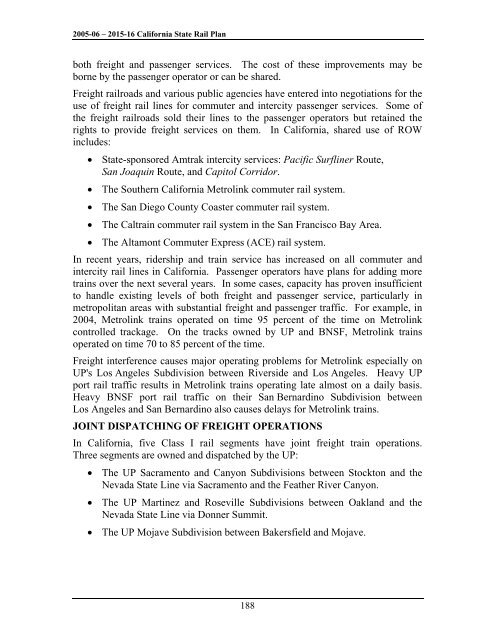California State Rail Plan 2005-06 to 2015-16
California State Rail Plan 2005-06 to 2015-16
California State Rail Plan 2005-06 to 2015-16
You also want an ePaper? Increase the reach of your titles
YUMPU automatically turns print PDFs into web optimized ePapers that Google loves.
<strong>2005</strong>-<strong>06</strong> – <strong>2015</strong>-<strong>16</strong> <strong>California</strong> <strong>State</strong> <strong>Rail</strong> <strong>Plan</strong><br />
both freight and passenger services. The cost of these improvements may be<br />
borne by the passenger opera<strong>to</strong>r or can be shared.<br />
Freight railroads and various public agencies have entered in<strong>to</strong> negotiations for the<br />
use of freight rail lines for commuter and intercity passenger services. Some of<br />
the freight railroads sold their lines <strong>to</strong> the passenger opera<strong>to</strong>rs but retained the<br />
rights <strong>to</strong> provide freight services on them. In <strong>California</strong>, shared use of ROW<br />
includes:<br />
• <strong>State</strong>-sponsored Amtrak intercity services: Pacific Surfliner Route,<br />
San Joaquin Route, and Capi<strong>to</strong>l Corridor.<br />
• The Southern <strong>California</strong> Metrolink commuter rail system.<br />
• The San Diego County Coaster commuter rail system.<br />
• The Caltrain commuter rail system in the San Francisco Bay Area.<br />
• The Altamont Commuter Express (ACE) rail system.<br />
In recent years, ridership and train service has increased on all commuter and<br />
intercity rail lines in <strong>California</strong>. Passenger opera<strong>to</strong>rs have plans for adding more<br />
trains over the next several years. In some cases, capacity has proven insufficient<br />
<strong>to</strong> handle existing levels of both freight and passenger service, particularly in<br />
metropolitan areas with substantial freight and passenger traffic. For example, in<br />
2004, Metrolink trains operated on time 95 percent of the time on Metrolink<br />
controlled trackage. On the tracks owned by UP and BNSF, Metrolink trains<br />
operated on time 70 <strong>to</strong> 85 percent of the time.<br />
Freight interference causes major operating problems for Metrolink especially on<br />
UP's Los Angeles Subdivision between Riverside and Los Angeles. Heavy UP<br />
port rail traffic results in Metrolink trains operating late almost on a daily basis.<br />
Heavy BNSF port rail traffic on their San Bernardino Subdivision between<br />
Los Angeles and San Bernardino also causes delays for Metrolink trains.<br />
JOINT DISPATCHING OF FREIGHT OPERATIONS<br />
In <strong>California</strong>, five Class I rail segments have joint freight train operations.<br />
Three segments are owned and dispatched by the UP:<br />
• The UP Sacramen<strong>to</strong> and Canyon Subdivisions between S<strong>to</strong>ck<strong>to</strong>n and the<br />
Nevada <strong>State</strong> Line via Sacramen<strong>to</strong> and the Feather River Canyon.<br />
• The UP Martinez and Roseville Subdivisions between Oakland and the<br />
Nevada <strong>State</strong> Line via Donner Summit.<br />
• The UP Mojave Subdivision between Bakersfield and Mojave.<br />
188













